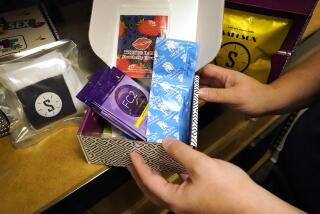Sex and risk among people in their 20s

Over the last few decades, the period between the time when young adults leave their parents’ house and when they settle down to start families has grown substantially. In 1970, 21% of 25-year-olds were unmarried; by 2005, the percentage had jumped to 60%.
Marked by self-discovery and exploration, this phase of life has been dubbed the “odyssey years” by some. And along with determining their career and life goals, many unmarried adults in their 20s are also trying to figure out how to manage their sex lives.
According to a poll published earlier this year by the National Campaign to Prevent Teen and Unplanned Pregnancy, 86% of unmarried people ages 18 to 29 are sexually active. And though it may not be surprising that 87% of the same group reported that they are not ready to have kids — including 88% of women and 86% of men — their actions don’t always line up with their intentions.
Among the group polled by the National Campaign, nearly half of those who are in a sexual relationship either don’t use contraception at all or use it inconsistently, and almost 20% of all respondents predict that they’ll have unprotected sex within the next three months.
The result? Seven in 10 pregnancies in the 18-to-29 age group are unintended, and men and women in their 20s have among the highest rates of sexually transmitted infections of any age group, including chlamydia, gonorrhea and syphilis.
“Teens get a lot of attention around childbearing and pregnancy,” says Heather Boonstra, senior public policy associate at the Guttmacher Institute, a New York and Washington, D.C.-based research organization that focuses on sexual and reproductive health. “But the age group that has the most trouble, and the highest rates of unintended pregnancy and abortion, are those in their early 20s.”
Lack of access to healthcare is part of the problem, says Boonstra, who authored “The Challenge in Helping Young Adults Better Manage Their Reproductive Lives,” a report published in the Guttmacher Policy Review in 2009.
People in their 20s “are the group most likely not to have health insurance today,” she says. According to the U.S. Census Bureau, approximately 27% of people ages 18 to 34 were uninsured in 2008, the highest of any age group. Without such coverage, contraception can cost anywhere from $10 to $70 per month for hormonal birth control such as the pill or the NuvaRing (that’s excluding the cost of a doctor’s visit to obtain such a prescription), and more than $700 up front for longer-term birth control such as an intrauterine device (IUD).
But most experts agree that young adults’ difficulty in managing their reproductive health is significantly affected by factors that run much deeper than access to care.
To begin with, the National Campaign discovered a considerable discrepancy among those ages 18 to 29 between perceived understanding and actual understanding of how to prevent pregnancy. Of those polled, 90% reported that they know everything they need to know to avoid pregnancy, yet nearly 80% of men and 30% of women in the same group said that they know “little or nothing” about the birth control pill. And 24% of all respondents believe that wearing two condoms provides double protection, when in fact it increases the chance of breakage.
And though they grew up in the era of “Sex and the City” and Internet porn, talking with partners about safe sex is just as difficult for people in this age group as for any other.
Catherine Toyooka, a Silicon Valley-based sex educator and founder of Catherine Coaches, a dating and sexuality education company, sees this difficulty firsthand. “They want to do the right thing,” she says of the young people who take her classes, “but it’s not really the easiest thing to talk about. They don’t have the skills.”
Adds Boonstra, “It takes a certain practice or finesse to be comfortable talking with your partner about sex and the use of contraception or condoms.”
Many young adults also have deep-rooted — and occasionally conflicting — feelings about becoming parents. Though they may not be ready for children at this point, many want kids someday, and 32% of those polled by the National Campaign said they’d be “very pleased” or “a little pleased” to find out that they or their partner were pregnant.
The percentage of men who reported that they would be pleased in the event of an unintended pregnancy was more than twice that of women.
But whatever the reasons behind it, no amount of magical thinking will negate the fact that ambivalence about safe sex can — and does — have lasting consequences.
Many common sexually transmitted infections can lead to serious health problems. Chlamydia, if left untreated, can cause infertility, and late-stage syphilis can be fatal.
When pregnancies are unplanned, the expectant mother is less likely to receive preconception care, which includes weaning off medications that might be harmful during pregnancy; managing maternal diseases such as diabetes and hypothyroidism, which can cause birth defects; and screening for sexually transmitted infections and HIV/AIDS.
And though a great deal of funding and resources has been put toward preventing teen pregnancy, in large part so that young women finish high school, Sarah Brown, chief executive of the National Campaign, emphasizes the fact that most employers now look for at least some college as well. Since many young people start and stop college several times before receiving a degree, an unintended pregnancy could disrupt what’s become a necessary level of education.
“The reality is that if you want to have a reasonably good job with any hope of stability, it requires two or even four years of additional education after high school,” Brown says.
To help young adults manage their sexual health, experts are now looking into ways to reach them with information that they will pay attention to.
Most agree that learning about safe sex starts well before the 20s. To that end, the federal government approved a $114.5-million teen pregnancy prevention initiative in December that will fund programs and research designed to reduce teen pregnancy and risky sexual behavior. The recently passed healthcare reform bill includes language that earmarks even more federal dollars for sex education.
For those who are out of — or well beyond — high school, the National Campaign is developing an interactive website and accompanying mobile application called Bedsider. The site will provide up-to-date information about sexual health, finding a healthcare provider and text-message reminders about safety geared toward people ages 18 to 29. The site’s launch is planned for early 2011.
In addition, the Centers for Disease Control and Prevention, which have taken note of the unique concerns of the twentysomething age group, partnered with several groups to launch a campaign last month called Get Yourself Tested, aimed at encouraging testing for sexually transmitted infections as well as open communication with partners and healthcare providers about the issue.
But as this complicated decade of life continues to evolve and as new norms are created, only time will tell what works, what doesn’t and what the future of young adulthood looks like.
“The reality is that childbearing and sex has unquestionably changed,” said Brown, “and I’m not sure that we are all entirely certain what the new structure is.”






